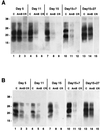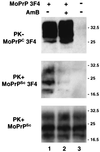Amphotericin B inhibits the generation of the scrapie isoform of the prion protein in infected cultures
- PMID: 10708429
- PMCID: PMC111813
- DOI: 10.1128/jvi.74.7.3135-3140.2000
Amphotericin B inhibits the generation of the scrapie isoform of the prion protein in infected cultures
Abstract
Transmissible spongiform encephalopathies form a group of fatal neurodegenerative disorders that have the unique property of being infectious, sporadic, or genetic in origin. Although some doubts about the nature of the responsible agent of these diseases remain, it is clear that a protein called PrP(Sc) plays a central role. PrP(Sc) is a conformational variant of PrP(C), the normal host protein. Polyene antibiotics such as amphotericin B have been shown to delay the accumulation of PrP(Sc) and to increase the incubation time of the disease after experimental transmission in laboratory animals. Unlike for Congo red and sulfated polyanions, no effect of amphotericin B has been observed in infected cultures. We show here for the first time that amphotericin B can inhibit PrP(Sc) generation in scrapie-infected GT1-7 and N2a cells. Its activity seems to be related to a modification of the properties of detergent-resistant microdomains. These results provide new insights into the mechanism of action of amphotericin B and confirm the usefulness of infected cultures in the therapeutic research of transmissible spongiform encephalopathies.
Figures




Similar articles
-
Effect of amphotericin B on wild-type and mutated prion proteins in cultured cells: putative mechanism of action in transmissible spongiform encephalopathies.J Neurochem. 2000 Feb;74(2):754-62. doi: 10.1046/j.1471-4159.2000.740754.x. J Neurochem. 2000. PMID: 10646527
-
Effects of new amphotericin analogues on the scrapie isoform of the prion protein.Biochim Biophys Acta. 2008 Oct;1780(10):1162-7. doi: 10.1016/j.bbagen.2008.07.005. Epub 2008 Jul 18. Biochim Biophys Acta. 2008. PMID: 18691635
-
Effect of Congo red on wild-type and mutated prion proteins in cultured cells.J Neurochem. 2000 Jan;74(1):222-30. doi: 10.1046/j.1471-4159.2000.0740222.x. J Neurochem. 2000. PMID: 10617123
-
Prion encephalopathies of animals and humans.Dev Biol Stand. 1993;80:31-44. Dev Biol Stand. 1993. PMID: 8270114 Review.
-
Insights into Mechanisms of Transmission and Pathogenesis from Transgenic Mouse Models of Prion Diseases.Methods Mol Biol. 2017;1658:219-252. doi: 10.1007/978-1-4939-7244-9_16. Methods Mol Biol. 2017. PMID: 28861793 Free PMC article. Review.
Cited by
-
Prion infection of epithelial Rov cells is a polarized event.J Virol. 2004 Jul;78(13):7148-52. doi: 10.1128/JVI.78.13.7148-7152.2004. J Virol. 2004. PMID: 15194791 Free PMC article.
-
Interaction of pathogens with host cholesterol metabolism.Curr Opin Lipidol. 2014 Oct;25(5):333-8. doi: 10.1097/MOL.0000000000000106. Curr Opin Lipidol. 2014. PMID: 25036592 Free PMC article. Review.
-
The Role of Vesicle Trafficking Defects in the Pathogenesis of Prion and Prion-Like Disorders.Int J Mol Sci. 2020 Sep 23;21(19):7016. doi: 10.3390/ijms21197016. Int J Mol Sci. 2020. PMID: 32977678 Free PMC article. Review.
-
Implications of peptide assemblies in amyloid diseases.Chem Soc Rev. 2017 Oct 30;46(21):6492-6531. doi: 10.1039/c7cs00372b. Chem Soc Rev. 2017. PMID: 28702523 Free PMC article. Review.
-
Prion-induced activation of cholesterogenic gene expression by Srebp2 in neuronal cells.J Biol Chem. 2009 Nov 6;284(45):31260-9. doi: 10.1074/jbc.M109.004382. Epub 2009 Sep 11. J Biol Chem. 2009. PMID: 19748890 Free PMC article.
References
-
- Adjou K T, Deslys J P, Lasmézas C, Demaimay R, Dormont D. Hypothèse sur les mécanismes d'action de l'amphotéricine B et de ses dérivés dans les encéphalopathies subaigües spongiformes transmissibles. Medecine/Science. 1997;13:892–896.
-
- Boesze-Battaglia K, Schimmel R. Cell membrane lipid composition and distribution: implications for cell function and lessons learned from photoreceptors and platelets. J Exp Biol. 1997;200:2927–2936. - PubMed
-
- Borchelt D R, Rogers M, Stahl N, Telling G, Prusiner S B. Release of the cellular prion protein from cultured cells after loss of its glycoinositol phospholipid anchor. Glycobiology. 1993;3:319–329. - PubMed
-
- Borchelt D R, Taraboulos A, Prusiner S B. Evidence for synthesis of scrapie prion proteins in the endocytic pathway. J Biol Chem. 1992;267:16188–16199. - PubMed
-
- Brown D A, Rose J K. Sorting of GPI-anchored proteins to glycolipid-enriched membrane subdomains during transport to the apical cell surface. Cell. 1992;68:533–544. - PubMed
Publication types
MeSH terms
Substances
LinkOut - more resources
Full Text Sources
Other Literature Sources
Research Materials

